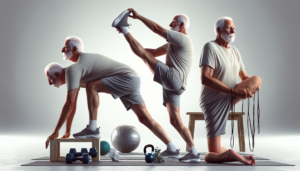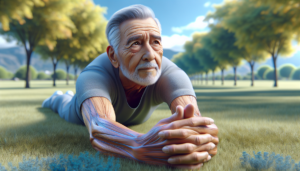Yoga for Older Men
Embarking on a yoga journey can be incredibly rewarding for older men seeking to enhance their fitness and well-being. Let’s explore the numerous advantages of yoga for seniors and how they can kickstart their yoga practice.
The Benefits of Yoga for Seniors
Yoga is not only a physical exercise but also a holistic practice that offers a wide array of benefits for older adults, particularly in maintaining and enhancing their overall health. Researchers are actively studying how safe and gentle yoga practices can improve seniors’ health (mmLearn).
Some key benefits of yoga for older men include:
- Improving flexibility and mobility
- Enhancing strength and balance
- Alleviating joint pain and stiffness
- Promoting relaxation and reducing stress
- Boosting mental clarity and focus
- Fostering a sense of community and connection
Engaging in a regular yoga routine can help older men adapt to the physical challenges that come with aging, leading to improved physical function, mental well-being, and quality of life (mmLearn).
For tailored yoga programs designed specifically for older men, options such as Man Flow Yoga offer structured routines focusing on weight loss, muscle gain, flexibility, and strength in a beginner-friendly format. These programs cater to individual lifestyles and schedules, making it easier for older men to incorporate yoga into their daily or weekly routines (Man Flow Yoga).
Starting a Yoga Practice
It’s essential for older men to approach their yoga practice with care and consideration for their unique needs and capabilities. Before delving into yoga, individuals should take time to evaluate their physical condition and consult with a qualified instructor who understands the specific challenges faced by seniors in yoga practice.
Gathering the necessary gear, including comfortable clothing, a yoga mat, and props if needed, can enhance the comfort and safety of the practice. Additionally, older men may find chair yoga to be a suitable option, especially if they have mobility limitations or balance issues. Chair yoga allows practitioners to engage in various poses while seated, offering a gentler approach to yoga practice (Great Senior Living).
By initiating a regular yoga practice, older men can reap the numerous physical, mental, and emotional benefits that yoga has to offer. It’s a journey of self-discovery, growth, and well-being, empowering older men to age gracefully while nurturing their holistic health. For more information on yoga poses tailored for older men, check out our article on yoga poses for older men.
Beginning Yoga Workouts
Embarking on a yoga journey as an older man involves tailored workouts designed to meet the unique needs and capabilities of this demographic. When starting a yoga practice, modified yoga poses and a focus on isometric strengthening are key components to consider to ensure a safe and effective practice.
Modified Yoga Poses
Yoga poses can be modified to suit any fitness level, body type, or age, making them accessible to individuals with limited mobility, chronic pain, injuries, or other health concerns. In a study conducted in 2013, specific yoga poses modified for older adults were evaluated to determine their physical demands on joints like the ankle, knee, and hip. These modifications are instrumental in increasing balance and decreasing the risk of falls (Forbes).
As a beginner, it is essential to find a yoga style that aligns with your fitness level and needs. Starting with basic yoga stretches can help build a solid foundation before progressing to more challenging poses. Yoga instructors guiding sessions for seniors often introduce variations or props to aid in achieving proper alignment and posture, enhancing the benefits of each pose while reducing the risk of injury.
Focus on Isometric Strengthening
Incorporating isometric strengthening-based yoga workouts is fundamental for older men looking to enhance body awareness, activate muscles effectively, and improve strength and flexibility. Isometric strength is the cornerstone of physical strength and should be mastered before delving into dynamic movements (Man Flow Yoga).
Isometric exercises involve engaging muscles without changing their length, promoting muscle endurance and stability. These static holds can help older men build functional strength, improve balance, and prevent injuries. Focusing on isometric strengthening in yoga practice can lay a solid groundwork for increasing bodyweight strength and endurance, vital for overall fitness and well-being.
By embracing modified poses and integrating isometric strengthening exercises into their yoga routines, older men can experience the holistic benefits of yoga, including improved strength, flexibility, balance, and mental well-being. These adjusted practices cater to the specific needs and capabilities of older men, fostering a safe and fulfilling yoga journey that supports their physical and mental health needs.
Importance of Low-Impact Exercises
As older men embark on their journey towards fitness and well-being, the significance of incorporating low-impact exercises cannot be overstated. For this demographic, joint-friendly activities like yoga play a pivotal role in enhancing physical health while minimizing the risk of injury. Let’s delve into the importance of low-impact exercises and how they can benefit older men specifically.
Joint-Friendly Yoga
Yoga, particularly Man Flow Yoga, is recognized for its joint-friendly nature, making it an ideal choice for older individuals looking to improve their fitness levels. The structured routines offered by programs like Man Flow Yoga are tailored to help older men lose weight, gain muscle, and enhance flexibility and strength in a beginner-friendly manner. These routines are designed to accommodate individual lifestyles and schedules, promoting consistency and long-term adherence.
The low-impact or no-impact nature of yoga makes it gentle on the joints, reducing the discomfort and pain often associated with higher-impact forms of exercise. Older men can engage in yoga practices without straining their joints, ensuring a safe and effective workout experience. Through modifications specifically crafted for individuals with low flexibility levels, Man Flow Yoga empowers older men to progress from their current fitness status without feeling overwhelmed.
Structure and Programs for Older Men
Structured yoga programs, like those offered by Man Flow Yoga, provide older men with a framework for their fitness journey. These programs are thoughtfully designed to cater to the unique needs and capabilities of older individuals, ensuring a gradual and sustainable approach to physical well-being. The focus on building strength, flexibility, and balance through accessible routines fosters progress and motivates older men to maintain an active lifestyle.
Moreover, incorporating yoga into their fitness regimen can help older men maintain muscle strength, preserve balance, and enhance flexibility, ultimately reducing the risk of injuries and supporting everyday activities. The adaptable nature of yoga allows for modifications to be made to accommodate specific conditions such as osteoporosis, arthritis, balance issues, and high blood pressure. This personalized approach ensures that older men can practice yoga safely and reap its numerous benefits.
It is imperative for older men to listen to their bodies during yoga practice and modify or discontinue poses if discomfort or pain arises. Keeping in mind individual limitations and utilizing props such as blankets or bolsters for support can enhance the safety and comfort of yoga sessions for older individuals. By embracing low-impact exercises like yoga, older men can embark on a fulfilling fitness journey that prioritizes their well-being and longevity.
Trends in Yoga for Seniors
In the realm of yoga for seniors, there has been a notable upsurge in interest among older adults in recent years. The shift towards embracing yoga as a form of fitness and wellness has brought about several trends that cater specifically to the unique needs and preferences of older men.
Growing Interest in Older Adults
According to the 2016 Yoga in America Study, nearly 14 million Americans over the age of 50 engaged in yoga practices, showcasing a substantial increase from four million in 2012. This growing interest underscores a shift towards holistic health approaches that promote physical strength, mental clarity, and emotional well-being among seniors.
Older adults, particularly men, are increasingly recognizing the benefits of yoga in improving flexibility, balance, and overall fitness levels. The accessibility of yoga classes tailored to seniors, as well as the emphasis on gentle movements and mindful breathing, has contributed to the rising popularity of yoga among this demographic. This trend highlights the importance of offering inclusive and supportive environments that cater to the diverse needs of older men.
Senior-Specific Yoga Options
With the surge in senior participation in yoga, there has been a corresponding emergence of senior-specific yoga options to address the unique requirements of older adults. As highlighted in a publication by LIDSEN Publishing Inc., seniors constitute more than a third of yoga practitioners in the United States, with a significant proportion aged 50 and above (LIDSEN Publishing Inc.).
Senior-specific yoga classes, workshops, and programs focus on adapting traditional yoga practices to accommodate the physical limitations and health considerations common among older adults. These specialized offerings place a strong emphasis on safety, sustainability, and individualized modifications to ensure that seniors can engage in yoga practices that enhance their well-being without risk of injury.
Moreover, given that approximately 85 percent of older adults have at least one chronic health condition (LIDSEN Publishing Inc.), there is a growing recognition of the role of yoga in addressing age-related health challenges such as hypertension, heart disease, and osteoporosis. By providing targeted yoga interventions that promote strength, balance, and flexibility, instructors and therapists have the potential to empower older men to improve their physical resilience and reduce the risks associated with falls and other age-related health issues.
The availability of diverse senior male yoga classes and senior men’s yoga workshops underscores the commitment of the yoga community to supporting the well-being of older men through tailored and effective yoga programs. Embracing the evolving trends in yoga for seniors can open up new avenues for promoting healthy aging and enhancing the quality of life for older men seeking to embark on their yoga journey.
Recommended Yoga Poses
When it comes to yoga for seniors, incorporating specific poses that cater to the needs of older men is essential for a safe and effective practice. Here, we highlight yoga poses that focus on enhancing balance and stability, as well as poses that promote flexibility and strength, ideal for older men beginning their yoga journey.
Poses for Balance and Stability
-
Mountain Pose (Tadasana): This foundational pose helps improve posture and balance by grounding the feet firmly into the mat while lengthening the spine. Mountain Pose encourages stability and can serve as a starting point to center oneself before moving into other poses.
-
Tree Pose (Vrikshasana): Tree Pose is beneficial for enhancing balance and focus. By shifting weight onto one leg and placing the sole of the foot against the inner thigh or calf of the opposite leg, practitioners can challenge their stability while also improving concentration.
-
Triangle Pose (Trikonasana): Triangle Pose targets the hamstrings, hips, and legs, promoting strength and flexibility. This pose engages the core muscles while stretching the body, making it a valuable addition for older men seeking stability and mobility.
Yoga Poses for Flexibility and Strength
-
Warrior I Pose (Virabhadrasana I): Warrior I Pose is excellent for building strength in the legs and core while stretching the arms and chest. This powerful pose helps older men improve both flexibility and strength, supporting overall mobility and endurance.
-
Downward Dog Pose (Adho Mukha Svanasana): A well-known yoga stretch, Downward Dog Pose provides a deep stretch for the chest, calves, hamstrings, and lower back. It enhances flexibility and strengthens multiple muscle groups simultaneously, making it a versatile pose for older men looking to improve their overall strength and range of motion.
By incorporating these recommended yoga poses into your practice, older men can experience the physical and mental benefits of yoga while focusing on improving balance, stability, flexibility, and strength. Remember, it’s essential to approach each pose mindfully, respecting your body’s limitations and progressing at your own pace. For more variations and guidance tailored to older men, consider exploring yoga poses for older men in senior male yoga classes or workshops. Yoga offers a holistic approach to wellness, promoting physical health, mental well-being, and a sense of calm and connection for older adults on their fitness journey.
Safety and Considerations
As older men embark on their yoga journey, ensuring safety and taking appropriate considerations is paramount to a positive and beneficial experience. It’s crucial to pay attention to physical evaluation and gear, as well as embrace slow progression and modifications tailored to individual needs.
Physical Evaluation and Gear
Prior to diving into a yoga practice, older men should undergo a thorough physical evaluation to assess their current fitness level and identify any specific health concerns. Understanding one’s physical capabilities and limitations is essential for crafting a yoga practice that is both safe and effective. It’s recommended to consult with a healthcare provider before starting any new fitness regimen, including yoga.
Gathering the appropriate gear is equally important for a comfortable and productive yoga session. Essential items include comfortable clothing that allows for ease of movement, a quality yoga mat to provide stability and support during poses, and any additional props such as blocks or straps that may assist in achieving proper alignment. Seeking out a qualified yoga instructor who has experience working with older adults is also beneficial, as they can provide guidance tailored to the unique challenges faced by seniors (Great Senior Living).
Slow Progression and Modifications
For older men starting their yoga journey, a gradual and deliberate approach is key to avoid injury and promote progress over time. It’s important not to rush into challenging poses but rather focus on building a strong foundation through foundational postures. Over time, individuals can gradually advance to more complex poses as their strength, flexibility, and balance improve.
Embracing modifications is another crucial aspect when practicing yoga as an older adult. It’s vital to listen to your body and modify or discontinue poses if discomfort or pain arises. Instructors should be informed of any physical limitations, such as arthritis or back pain, to ensure that the practice is safe and appropriate. Seeking out modified versions of poses that accommodate individual needs can help reduce the risk of injury and enhance the overall yoga experience.
Yoga postures, known as asanas, aim to strike a balance between effort, ease, stability, and comfort. By focusing on the coordination of movement and breath, older men can enhance their focus, improve mood, and reduce stress levels. The incorporation of modifications and props, such as blankets or bolsters, can provide additional support and customization to meet the specific needs of older adults while practicing yoga (Forbes). Practicing yoga mindfully and with awareness of individual limitations can help older men derive the maximum benefits from their yoga practice while staying safe and injury-free.



